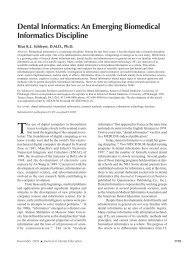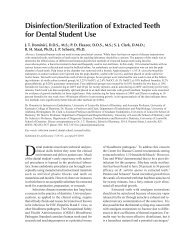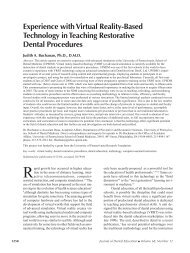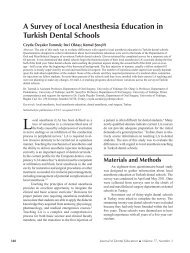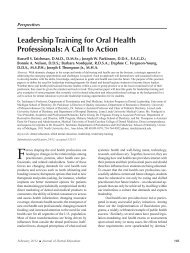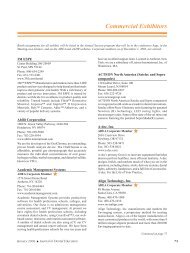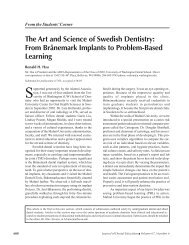Physical and chemical aspects of saliva as indicat... - ResearchGate
Physical and chemical aspects of saliva as indicat... - ResearchGate
Physical and chemical aspects of saliva as indicat... - ResearchGate
You also want an ePaper? Increase the reach of your titles
YUMPU automatically turns print PDFs into web optimized ePapers that Google loves.
dence that other electrolytes have any role in establishing<br />
an incre<strong>as</strong>ed risk for caries. 10,12,24,45,46,69 There is also<br />
little to no evidence that <strong>saliva</strong>ry small molecules have<br />
any role in establishing an incre<strong>as</strong>ed risk for caries.<br />
12,16,24,30,45,46,50,69,70,71,72 Interpretation <strong>of</strong> this information<br />
is complicated, however, by the wide range <strong>of</strong> reported<br />
me<strong>as</strong>urements for these components in <strong>saliva</strong>.<br />
Salivary immunoglobulins. Twenty-two studies<br />
examined the relation between <strong>saliva</strong>ry immunoglobulins<br />
<strong>and</strong> caries status. 12,16,29,30,45,46,50,73-87 The levels <strong>of</strong> specific<br />
sIgA showed a modest inverse relationship with<br />
caries risk, <strong>and</strong> the literature is nearly equally divided<br />
for <strong>and</strong> against an anticaries role <strong>of</strong> specific sIgA. Seven<br />
studies reported an inverse relationship between specific<br />
sIgA antibodies in <strong>saliva</strong> (for example, anti-S.<br />
mutans sIgA) <strong>and</strong> caries status, 74,79,81-85 while two studies<br />
reported that caries w<strong>as</strong> related to incre<strong>as</strong>ed levels <strong>of</strong><br />
specific sIgA 80,86 <strong>and</strong> five studies reported no relationship<br />
between specific sIgA immunoglobulins <strong>and</strong> caries.<br />
16,29,30,77,87 With one exception, these reports examined<br />
subjects who were healthy or had medical<br />
conditions not directly related to immunoglobulin deficiency.<br />
30 The levels <strong>of</strong> total sIgA, in contr<strong>as</strong>t to specific<br />
sIgA, were found not to be good risk <strong>indicat</strong>ors.<br />
Although IgG <strong>and</strong> IgM may be compensatory in sIgA<br />
deficient subjects, there is insufficient evidence to establish<br />
a role for these immunoglobulins in caries risk.<br />
Salivary innate non-immunoglobulin factors.<br />
Fourteen studies examined the relationship between<br />
caries <strong>and</strong> one or more <strong>of</strong> the following <strong>saliva</strong>ry factors:<br />
total protein, acidic or b<strong>as</strong>ic proline-rich proteins<br />
(PRPs), statherins, histatins, peroxid<strong>as</strong>e/<br />
myeloperoxid<strong>as</strong>e, lysozyme, lact<strong>of</strong>errin, amyl<strong>as</strong>e, sucr<strong>as</strong>e<br />
activity, <strong>saliva</strong>ry glycoconjugates,<br />
<strong>and</strong> bacteria-aggregating glycoproteins<br />
(BAGPs). 10,12,24,29,30,40,45,46,50,58,69,83,88,89 Virtually all these<br />
studies found no relationship with caries status.<br />
Sjögren’s syndrome <strong>and</strong> <strong>as</strong>sociated conditions.<br />
Three studies evaluated both primary (pSS) <strong>and</strong> secondary<br />
(sSS) forms <strong>of</strong> Sjögren’s dise<strong>as</strong>e, 1,8,90 <strong>and</strong> two<br />
studies evaluated subjects having only pSS. 10,11 Both<br />
pSS <strong>and</strong> sSS were found to be unequivocally <strong>as</strong>sociated<br />
with incre<strong>as</strong>ed caries risk, which w<strong>as</strong> exclusively<br />
due to the pathologically decre<strong>as</strong>ed flow rate observed<br />
in Sjögren’s patients. Neither pSS nor sSS subjects had<br />
any discernible alterations in mean <strong>saliva</strong>ry pH or buffer<br />
capacity, <strong>and</strong> these were not <strong>as</strong>sociated with caries risk<br />
in the studies. Scleroderma is a connective tissue disorder<br />
<strong>as</strong>sociated with sSS, <strong>and</strong> one additional study<br />
found a relationship between scleroderma-related xerostomia<br />
<strong>and</strong> caries prevalence. 91<br />
Radiation, chemotherapy, <strong>and</strong> surgery. Five<br />
studies examined subjects who had received only chemotherapy<br />
without any radiation to the jaws, 34,43,58,60,75<br />
<strong>and</strong> two studies examined subjects who had received a<br />
combination <strong>of</strong> chemotherapy <strong>and</strong> total body irradiation<br />
(that is, bone marrow transplant patients). 23,37 No<br />
evidence w<strong>as</strong> found for an <strong>as</strong>sociation between caries<br />
<strong>and</strong> chemotherapy or total body irradiation. With respect<br />
to local radiation damage <strong>of</strong> the head <strong>and</strong> neck<br />
area, the literature contains sparse evidence b<strong>as</strong>ed on<br />
controlled clinical studies having adequate sample size;<br />
much stronger <strong>as</strong>sociations come from descriptive studies<br />
<strong>and</strong> individual c<strong>as</strong>e reports, which were excluded<br />
here. One study reported equivocal findings on the effects<br />
<strong>of</strong> surgical retropositioning <strong>of</strong> sublingual <strong>saliva</strong>ry<br />
ducts (sialodochopl<strong>as</strong>ty), 62 <strong>and</strong> no studies examined surgery<br />
to the <strong>saliva</strong>ry gl<strong>and</strong>s per se.<br />
Use <strong>of</strong> medications having xerostomic side effects.<br />
Although somewhat limited, the evidence reported<br />
here continues to support the belief that certain medications<br />
that have xerostomic side effects may lead to an<br />
incre<strong>as</strong>ed risk <strong>of</strong> caries. 12,13,92,93 This risk results from<br />
chronically lowered <strong>saliva</strong>ry flow rate rather than other<br />
alterations in <strong>saliva</strong>, for example, poor buffering capacity.<br />
It is important to note that none <strong>of</strong> the studies<br />
me<strong>as</strong>ured the effect <strong>of</strong> discontinuing medication on<br />
<strong>saliva</strong>ry output, so that these findings could be inaccurate<br />
regarding the “incre<strong>as</strong>ed risk” for dental caries.<br />
Other conditions. A number <strong>of</strong> articles attempting<br />
to correlate caries with <strong>saliva</strong>ry disturbances in several<br />
other conditions were also found. These included<br />
both insulin- <strong>and</strong> noninsulin-dependent diabetes,<br />
35,39,51,52,54,94 anorexia <strong>and</strong> bulimia, 9,17,53,63 chronic<br />
malnutrition, 7 Crohn’s dise<strong>as</strong>e, 50 cleft lip <strong>and</strong> cleft palate,<br />
2 various heart conditions, 32,35,76 chronic renal failure,<br />
27 common variable immunodeficiency, 30<br />
<strong>as</strong>thma, 12,31,69,93 Down’s syndrome <strong>and</strong> non-Down’s mental<br />
retardation, 95,96 spinal cord injury, 14 <strong>and</strong> thal<strong>as</strong>semia<br />
major. 46 None <strong>of</strong> these articles provided convincing evi-<br />
Table 2. Summary <strong>of</strong> the evidence according to the strength <strong>of</strong> <strong>as</strong>sociation between <strong>saliva</strong>ry characteristics <strong>and</strong><br />
caries risk<br />
Strong Association Weak-to-Moderate No Association<br />
with Caries Risk Association with Caries Risk with Caries Risk<br />
Flow Rate Buffering Capacity; Calcium/Phosphate; pH (static me<strong>as</strong>urement); Glucose Clearance<br />
Specific sIgA Immunoglobulin<br />
Rate/Concentration; Other Electrolytes & Small<br />
Organic Molecules; Total sIgA; IgG, IgM, Innate<br />
Immunity Factors<br />
October 2001 ■ Journal <strong>of</strong> Dental Education 1057



